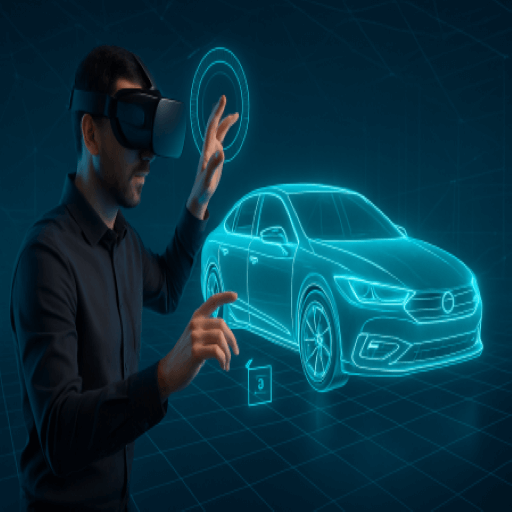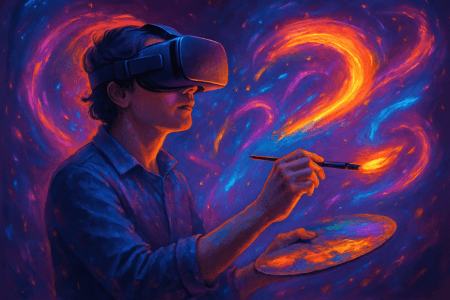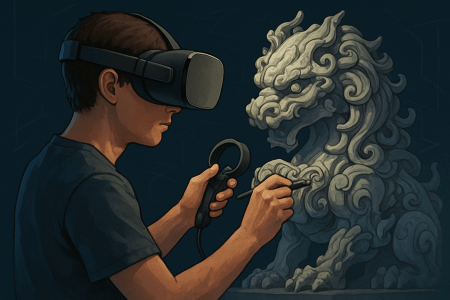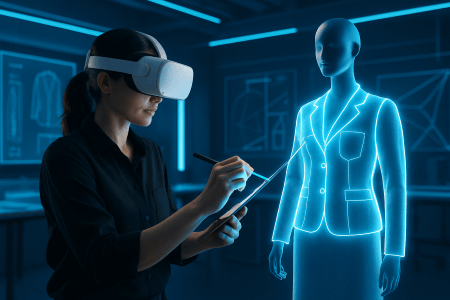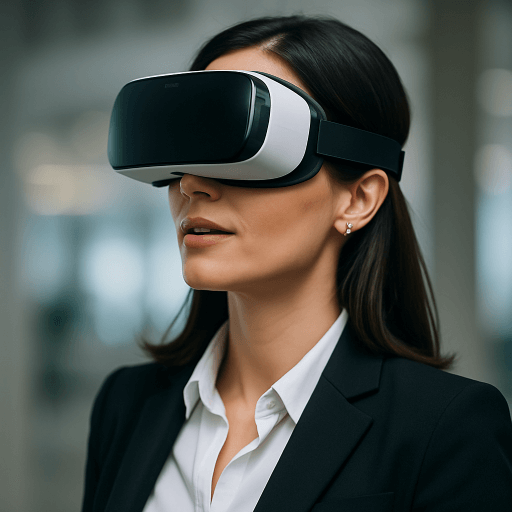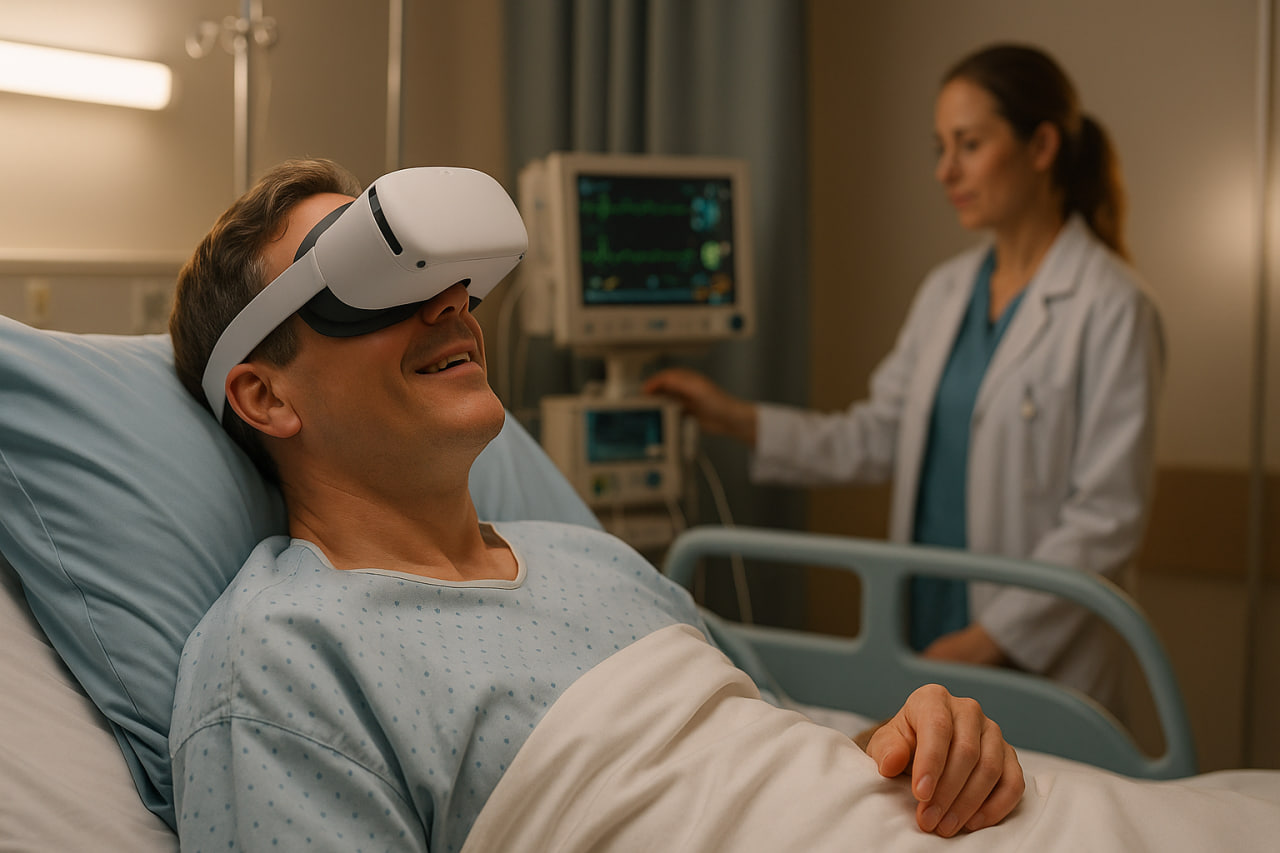Ever wondered what it’s like to paint in the air or design a car, a dress, or a sculpture—without touching a single real material? What if mistakes didn’t cost a thing?
It’s worth exploring the future of Virtual reality and seeing what it could look like in creative fields.
How VR Makes Art Creation Cheaper?
If there’s one thing technology really did for us, it was saving resources. I can’t speak for every single field, but just think about paper. Since the internet came along, and later smartphones, people read their articles on screens instead of in physical newspapers or magazines. Back then, countless trees had to be cut just to produce those papers.
Sometimes I can’t help but think about art students. Poor them. The supplies are expensive, and I can only imagine how stressful it must be to buy these things regularly. What if they mess it up? Do they have to buy another canvas each time? Honestly, I don’t know the exact process or how it works for them. Maybe they practice enough before painting on it. Anyway, art is a costly field, and students have to constantly invest in supplies.
Think of VR as your practice space. It saves you from wasting pricey supplies and lets you play around as much as you want before even touching a real canvas. If you’re interested, our custom VR development service can build a painting app tailored exactly to your needs
But what is VR painting?
What does painting in VR look like? Well, it’s basically the same as painting in the real world, except you don’t need any of the usual supplies. You put on the headset to paint, and that’s it; you have your canvas, your colors, and your brush, and you start stroking the canvas just like in the real world. Whatever you paint: nature, animals, or people—appears right there on your canvas.
You might ask, “Why paint in VR? Can’t people just use paper or an iPad app instead?” Well, why did people start drawing on iPads in the first place, couldn’t they just stick to paper? The truth is, art is art. There’s no right or wrong way to do it; it all comes down to personal taste. Whichever medium you feel drawn to is the right one for you.
But why is VR painting so special and different from the traditional painting we know?
Painting doesn’t have to be confined to a canvas. Artists paint on walls, in the streets, or anywhere that offers the right surface. In VR painting, there’s a gadget that takes the place of a pencil. You hold it, move it, wave it around, and just like that, you’re drawing in the air.
Why use VR for painting?
I bet you know Bob Ross, the curly-haired famous American artist, whose show was super watchable even for people who didn’t know a thing about drawing. But for an artist, mimicking his style and learning from him is a good reason to watch.That’s why some VR painting apps use Bob Ross’s old videos to guide you while you paint, so it feels like he’s teaching you in VR.
On top of that, many apps let artists render their finished work, so you can print it on canvas, paper, or other surfaces. So, it’s not just some VR world experience you might think would leave you with nothing physical to show.
If you need an app like this, we can design one just for you, with everything you need, and even add a print option so you can have your work in physical form at the end.
Sculpting with VR
While writing this section, I was reminded of Leonardo da Vinci. Once, the Duke of Milan asked him to create a bronze statue in memory of his father. He worked for months on the design and first built a clay model. But the project was never finished because war broke out, and the duke needed every ounce of bronze for weaponry. It just made me think of how delicate and time-consuming the art of building sculptures really is.
Sure, technology has made the process of building sculptures faster, but just think about how much material could be saved if we had the ability to model our sculptures in a VR world. You could try out different ideas, see how they turn out, and only start building the masterpiece after exploring many possible scenarios.
Designing Clothes in VR
Before VR, you couldn’t even imagine this : standing in front of a model and sketching clothes right onto them with a digital tool. A blouse, pants, whatever design pops into your head, you can bring it to life instantly.
Why is VR such a big deal in fashion? Simple, it saves time. Normally, designers make a sketch, then sew it, then throw it on a mannequin to see if it looks as cool as it did in their head. With VR, you just sketch in 3D and boom: the outfit is standing right in front of you, whatever size you want. You can tell right away if it’s worth taking to the sewing stage or not.
Imagine how much time and material could be saved if designers had VR back then. It’s possible now, and If you need one, we can help you with that.
Virtual Car Modeling
Last year, while reading Elon Musk’s biography, I came across a chapter about how obsessed he was with Tesla’s design. He was involved in every detail, and the person he had in mind while designing the car was his wife at the time. He’d have her sit in the prototype and ask if she was comfortable, if she liked the elegance of every part. He used her feedback to keep refining the car, and the result was something truly remarkable.
The bottom line? Yes, a car’s appearance really matters. If the richest man in the world cared that much to get personally involved, it says a lot. I remember a technically excellent car that came to my country a few years ago—but production didn’t last, and very few were sold. Why? It was ugly.
These days, designers are using VR to create cars, and it’s incredible. They can see their designs take shape in front of their eyes, get instant feedback, and interact with the design in ways that sketching on paper just can’t match.
Virtual reality for Filmmakers
In filmmaking, VR can solve a bunch of big problems. Take sets and decorations, for example, they take tons of time and money to build. And that’s not even the worst part. The real headache comes when a set suddenly doesn’t work anymore, maybe the plan changes, or when you see it in person, it just doesn’t look as good as you imagined. With VR, directors can build their entire vision in a virtual space, see it almost exactly as it would look in real life, and decide if it’s worth constructing for real.
Directors throughout history have faced obstacles in unique ways. Often, their ideas had to stay locked in their minds because the technology simply didn’t exist yet. Take James Cameron, for example, he had the idea for Avatar years before the technology was ready, and he ended up inventing much of it himself after years of work.
But even when technology exists, practical challenges still get in the way. One big headache for directors is scouting locations. Traveling with a crew can be expensive, each day of accommodation adds up quickly. Imagine if directors could explore locations in advance without leaving their office.
A well-designed VR app can let them walk through exact real-world locations virtually, find the perfect spots, and plan every detail before ever setting foot on site. It saves time, reduces costs, and makes location scouting far more efficient. Here at VRLex, we can design that exact app for you. Many studios solve this problem by working with a custom VR development service that can tailor the app exactly to their needs.
Another big challenge for creative and hardworking directors is camera placement. They often try countless angles to get the perfect shot. Now, imagine if they’re perfectionists—how many times would they move the camera? With VR, they can experiment as much as they want, testing different angles virtually. Once they find the right setup, they can place the camera in the exact position in real life, saving tons of time and avoiding frustration. And if you think this isn’t a big deal, trust me—it really is.
The future of virtual reality goes far beyond gaming, and it’s about to show everyone just how widely it can be applied.
Thanks for reading! If you have any questions about these topics, or want to try out apps like the ones I mentioned —just drop me a message on WhatsApp.
- How do artists paint with VR apps?
They put on the headset and grab the gadget that works as their brush. They can see their canvas and all the tools they need, just like in real life, but in VR, you can make the canvas bigger or smaller, move it around. - Can we experience our drawings outside of the canvas? How?
Yes! With VR apps, you can draw in the air and see your work in full 3D, so your creation isn’t limited to a flat surface. - How does VR help fashion designers?
Designers can use VR to create clothes and see how they look on a mannequin without actually sewing anything. They get to see the design come to life on a body before making a real garment. - How is VR used in car design?
VR apps for car design help designers explore more creativity and see possibilities they might not have imagined. - Can VR help artists reduce wasted materials when building sculptures?
Yes! You can build your model in VR first instead of, say, using clay. After experimenting different ideas in VR, you can then work on the real version, saving materials and effort.
